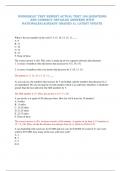WONDERLIC TEST NEWEST ACTUAL TEST 180 QUESTIONS
AND CORRECT DETAILED ANSWERS WITH
RATIONALES|ALREADY GRADED A| LATEST UPDATE
What is the next number in the series? 5, 15, 10, 13, 15, 11, ___
A. 9
B. 13
C. 10
D. 20
E. 15
F. None of these
The correct answer is (D). This series is made up of two separate subseries that alternate:
1. A series of numbers (the odd terms) that increase by 5 (5, 10, 15).
2. A series of numbers (the even terms) that decrease by 2 (15, 13, 11)
The pattern is: 5, 15, 10, 13, 15, 11, ___
As you can see, the numbers that increase by 5 are bolded, and the numbers that decrease by 2
are underlined. We are missing the seventh number which is an odd term; therefore, it should be
greater than the last odd term (the fifth number) by 5.
The fifth number is 15. Thus, the answer is 15 + 5 = 20
A car travels at a speed of 85 miles per hour. How far will it travel in 15 minutes?
A. 9 miles
B. 11 miles
C. 13.25 miles
D. 21.25 miles
E. 22.75 miles
F. None of these
The correct answer is (D). An hour consists of 60 minutes. A quarter of an hour is 15 minutes as
15 * 4 = 60. Thus, divide the distance traveled per hour by 4, which is 85/4=21.25.
A car dealership sells used cars for $7,000 and new cars for $16,000. If a total of 17 cars were
sold for $191,000, how many of the cars sold were used?
A. 2
B. 3
C. 5
D. 8
,E. 10
F. None of these
The correct answer is (F) - None of the above.
First of all, in order to simplify the calculations we can divide all the numbers by a common
denominator: 1000, in that way we can get rid of all those annoying zeroes. Now we define the
used cars as U (with a price of 7 each) and the new cars as N (with a price of 16 each) Now we
can build two equations, the first representing the total price and the second the total amount of
cars:
a. 7U+16N=191
b. N+U= 17
So according to the second equation N = 17-U, and we can now substitute N in the first equation:
7U+16(17-U)=191 ; 7U+272-16U=191 ; 9U=81 ; U=9. 9 used cars were sold.
Solving Tip: You could try solving this question by elimination. For starters, since 191 is an odd
number and 16 is an even number, then the number of used cars must be odd (even+odd=odd) -
which means we can eliminate answers A, D & E. Now that we are left only with B and C, let's
try to calculate it for each of these options:
. 37 + 16*(17-3) = 245, which means we can eliminate B as an answer.
. 57 + 16*(17-5) = 227, which means we can eliminate C as an answer.
Therefore, the only possible answer is F - none of the above.
Joey got a 25% raise to his salary. If his original salary was $1,200, how much was it after the
raise was implemented?
A. $1225
B. $1500
C. $1350
D. $1450
E. $1800
F. None of these
The correct answer is (B). 25% equals one quarter and a quarter of 1200 is 1200/4=300.
Therefore, an addition of a quarter to 1200 equals 1200+300=1500.
Arrange the following words so that they make a complete sentence. Is the rearranged sentence
true or false?
Triangle A sides three has
, A. True
B. False
The sentence is: A triangle has three sides, which is true.
________ is to JUICE as WHEAT is to BREAD
A. Water
B. Pitcher
C. Supermarket
D. Soda
E. Orange
The correct answer is (E). An orange is used to produce juice like wheat is used to produce
bread. In addition, both wheat and oranges must be processed to produce the final product. This
eliminates answer (A).
Does FAQ mean "frequently asked questions"?
A. Yes
B. No
Yes, FAQ is the acronym for "frequently asked question".
ATTRACTION is the opposite of:
A. Disgust
B. Inclination
C. Fascination
D. Inducement
E. Lust
The correct answer is (A). Attraction is a word used to describe the power of drawing, alluring or
enticing while disgust is a word used to describe a feeling of loathing that causes aversion.
In the following set of words, which word does not belong?
A. Dentist
B. Economist
C. Surgeon
D. Layman
E. Neuropsychologist
The correct answer is (D). A layman is a word used to describe a person who does not belong to
a particular profession while the other words are all different professions.
DEVIATE AGITATE - The meanings of these words are:
A. Similar
B. Contradictory
C. Neither similar nor contradictory




